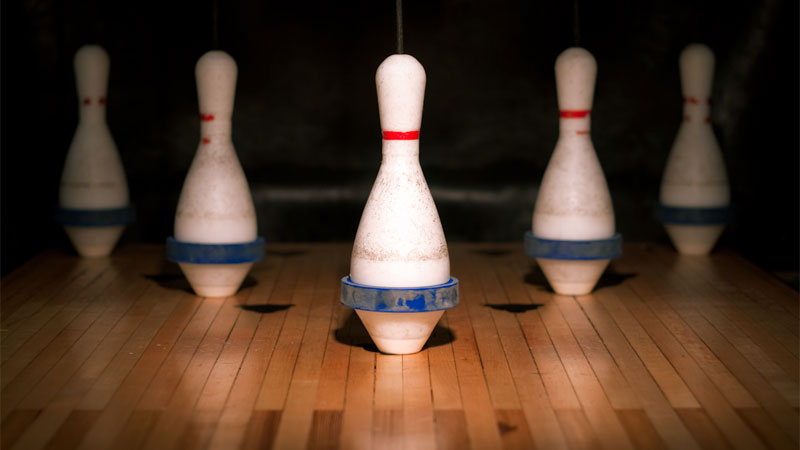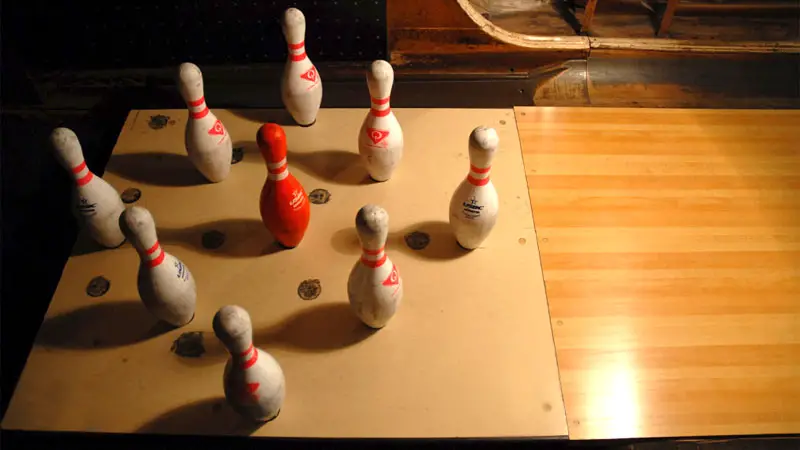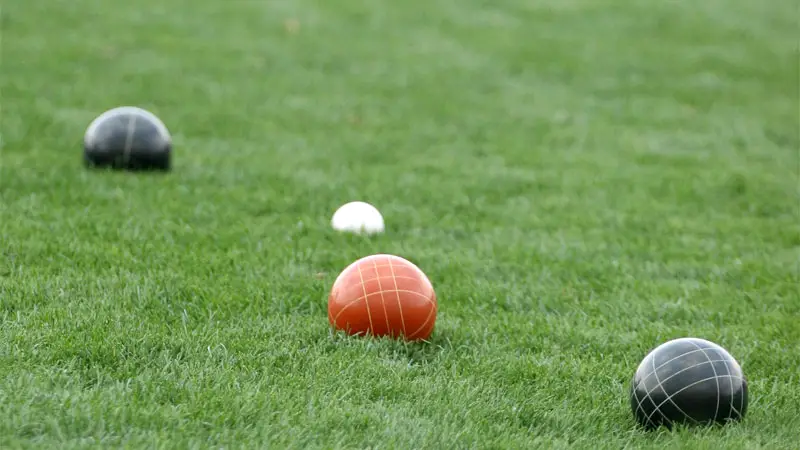Bowling is one of those sports where everyone thinks they know all there is to know about the game… until someone mentions there’s more than one kind of bowling.
In fact, bowling is one of the oldest games out there, with its origins dating back to at least 5,200 BC. Today, bowling is divided into two separate categories: target bowling and pin bowling.
Target bowling games involve throwing or rolling a ball to get closest to a target. Pin bowling, conversely, involves rolling a ball in an attempt to knock down pins.
Here are all five common pin bowling games as well as some target bowling games you might have actually played before.
See Also: 14 Types of Basketball Dunks
Different Types of Bowling
1. 5-Pin Bowling

Created by Thomas F. Ryan of the Toronto Bowling Club in 1909, 5-pin bowling is a popular game in Canada, although it’s rarely played in the US. The game uses special pins that are approximately 75 percent of the size of 10-pin pins. Likewise, the balls are small enough to fit in the hand and usually lack any finger holes.
The game itself has a complicated scoring system in which each pin is worth a different amount of points based upon where in the V formation it’s located. This adds a lot more strategy, as the player must choose which pins to aim for if he fails to get a strike.
2. 9-Pin Bowling

Sometimes simply referred to as nine-pins, this is a more traditional form of bowling that remains highly popular in Europe, although it was supplanted in the US by 10-pin bowling.
Nine-pins is infamously remembered as the game being played when Rip van Winkle fell into his 20-year slumber. Oddly enough, Washington Irving’s 1819 take proved prophetic, as the game was banned in many major US in the 1830s over fears that it led to laziness and drinking, nearly 20 years after the story was penned.
Texas was the main exception, which chose to tax its bowling alleys instead of closing them down. Despite popular claims that 10-pin bowling was invented as a replacement, the latter was already being played in England in 1810, possibly earlier.
The American Bowling Congress created standardized rules in 1895 and the game is often played on a standard non-oiled 10-pin lane in US bowling alleys. However, the size and shape of 9-pin lanes varies in other countries, as are some of the rules.
The ball generally has no finger holes, although a two-finger version is available for beginners. Scoring is very different, with a bowl that knocks down all nine pins scoring nine points, a bowl that knocks down all but the central pin scoring 12 points, and bowls that fail to do either carrying no score unless it’s the final bowl of the frame.
Teams often employ members who specialize in hitting the pins in certain ways, increasing the chance of gaining a “ringer”.
3. 10-Pin Bowling

This is the single most recognized form of bowling out there. In this game, the player uses a weighted ball with 2-3 finger holes to try and knock down ten pins. The game got its start in the early 1800s, but didn’t have standardized rules until the end of the century.
The playing “field” is a lane 41.5 inches wide with two gutters running its length. The floor is made of either 39 wooden boards or a synthetic material and extends beyond the actual lane.
Within the lane, it’s 60 feet from the foul line to the first pin, with an additional 15-foot approach leading up to the foul line. The lane itself is coated with an oil from the foul line to ⅔ of its length.
Games are scored using rounds known as frames (based on the scoring sheet). The goal is to knock down as many of the ten pins as possible. If all 10 pins are knocked down on the first try, the player gets a strike, which gives them a bonus. If 10 pins are knocked down in two bowls, a smaller bonus is granted.
There are two bowls per frame (unless there’s a strike), after which the score is tallied. Up to two additional frames are granted to a player who gets a strike on the 10th (final) frame. Scoring of professional and amateur bowling differs, however the maximum possible score is 300, requiring 12 strikes in a row (i.e. a perfect game).
Read Also: 9 Types of Fishing Reels
4. Bocce

This target bowling game evolved from a Roman bowling game and is one of the more popular games belonging to a family of target bowling games known collectively as boules. While the exact age is unknown, the first known documentation of regulatory rules was published in 1753 in the book “Gioco delle bocchie”.
It’s a popular game throughout much of the world and is accessible enough that it’s among the most popular sports played by Special Olympics athletes.
The game is played on a rectangular court that measures 90 feet long and 13 feet wide. The court can be made of various materials, including clay, grass, cement, asphalt, artificial turf, sand, or granite.
The objective of the game is to get your bocce balls as close as possible to the smaller target ball, called the pallino. Games may be played between two players or teams of up to four people.
At the beginning of each frame, a player from one team throws the pallino onto the court. The same player then throws one of their bocce balls, trying to get it as close to the pallino as possible.
The team with the closest bocce ball to the pallino scores one point for each of their balls that are closer to the pallino than the other team’s closest ball. The game continues in this manner until one team reaches a predetermined number of points, typically 12 or 16.
See Also: 19 Kinds of Barbells Found in the Gym
5. Candlepin Bowling

Played mostly in New England and parts of Canada, This game has somewhat fuzzy origins. It is believed to have been invented in 1880 by Justin White, but there are also claims that John J. Monsey deserves the credit in 1881, although supporters of White claim Monsey just helped to standardize the rules.
Whatever the case may be, candlepin bowling got its origins in Worcester, Massachusetts, and Monsey created the National Duckpin and Candlepin Congress in 1909 to create standard rules and equipment.
Today, the candlepins, which are cylindrical in shape and measure 15-3/4 inches tall and 2-15/16 inches wide, sit on unoiled lanes and are bowled using a small 4-1/2 inch ball that lacks holes.
Three bowls are allowed per frame, and fallen pins, AKA “wood”, are not picked up between the bowls of a frame. This affects scoring, as hitting “dead wood” (fallen pins in the gutter) before hitting a standing pin results in no score.
Because of the shape of the pins, it’s possible to knock fallen wood in a way that returns it to a standing position, at which point it counts as live wood even though it’s already been scored. The most points ever won during a game was 245, scored in 1984 and 2011, although the maximum possible score is 300.
6. Duckpin Bowling

This pin bowling game is very similar to 10-pin bowling in terms of rules, but the equipment is very different. We don’t know when or where this game was invented, but we do know it was already being played in Boston in 1892.
Duckpin bowling has pins that look a lot like the pins for 10-pin bowling, only they’re smaller, measuring around 9.5 inches tall and 4-3/4 to 5 inches wide. The ball is also smaller and fingerless, measuring around five inches tall, which is just slightly bigger than the ball used in candlepin bowling.
The size of the ball and pins makes scoring a strike much harder, and players get three bowls per frame instead of two. Other than this, there’s very little difference from 10-pin bowling in the main version of the game.
However, a mini duckpin game exists, which uses a shorter lane. This makes it easier to score strikes, and 300 games are not uncommon, whereas the highest certified score for the standard game was 279, recorded in 1992.
A third official variation of the game, rubber band duckpins, also exists and was invented in 1905 by William Wuerthele of Pittsburgh, Pennsylvania.
The only difference with this version is that the pins are ringed by a rubber band which improves scoring. The rules for rubber band duckpin bowling are identical to 10-pin bowling and perfect games are not uncommon.
7. Skittles

This popular pub game is the forerunner to 9-pin bowling and is a target game, rather than a pin game. Rules vary widely from one location to another, and the game can be played both as an indoor game or a lawn sport.
The balls can be round or oval in shape, while the skittles (AKA pins) can look like either small 10-pin pins or small candlepins.
In some variations of the game, the goal is to knock down all of the pins, while in others the goal is to knock down specific pins. The number of pins can also vary, although nine is the most common number.

